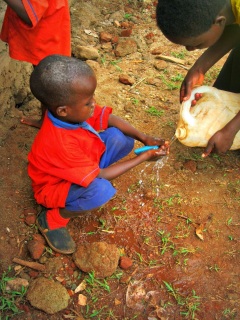To view our most recent newsletter…
News
Welcome to our new website. Links to our newsletters will be posted here. If you would like to receive Small Steps Foundation newsletters directly to your inbox click here
Unfortunately our old website is no longer avaliable. To find links to old news please visit our Facebook page.
Maria’s Story
 |
| Maria, new to our SEN staff team. |
This is Maria. We didn’t employ her because she has a masters in special needs education or comes with a blinding resume filled with relevant training courses and a steep progression of promotions. No, we employed Maria because he is a single mother of a child with cerebral palsy who has battled against the odds to bring up her son. And in our eyes, that (along with her teaching qualification) makes her the perfect candidate for Small Steps Foundation.
 |
| This handsome guy is Aslam, Maria’s son. |
Maria is not sure of the origin of Aslam’s CP. All she knows is that as he grew and it became clear that he had a disability, her husband grew unhappy. “He has many wives,” she told me. “He said ‘None of my other wives produce children like this. This is your fault! You go away with your child!'”
I asked her if she was sad when this happened. She laughed and said, “At first I cried but then I realised he wasn’t a good man and I’m better off alone.”
Maria went back to her mother’s home with Aslam and his older sister. Her mother is elderly, she told me, so other than a roof over their heads could offer no other assistance.
 |
| Maria’s love for Aslam is clear and prevailing |
“I went from place to place looking for a job. I am a teacher so I thought it wouldn’t be too hard. But everywhere the told me they can’t accept me to come with Aslam and I didn’t want to leave him somewhere so I couldn’t work.
 |
| Maria helped Sosi with his writing in the SEN class |
“The neighbours told me ‘You leave that child somewhere and get on with your life’ others told me I was wasting my time on him and I should abandon him. But he is my child and if I can’t care for him, who will? So I suffered like that. Some people we’re friends to me, others refused me as a friend because they thought I was cursed.”
It wasn’t until last year, when Mary, Buwenda Women in Action chairperson, SSF community liaison and mother/grandmother extraordinaire, was visiting her husband’s family in the village and met Maria that things started looking up.
Mary invited Maria to visit us a Glory Be Nursery so that Aslam could undergo assessment and referral. On realising that Maria was a qualified teacher and that we were looking to expand our SEN staff team, headteacher Immaculate did no hesitate in interviewing and subsequently employing Maria and offering a place to Aslam in the SEN class.
“I am so happy now,” smiles Maria. “I am working and my boy is learning. He is learning new words and how to help himself.” She says she has no regrets leaving her village and joining us and at least feels safe and accepted.
 |
| Aslam works on his prewriting skills while in the standing frame |
Maria has the patience, adaptability and most of all the love for children with disability which is the cornerstone of SSF’s work. We feel so privileged to have the opportunity to work with such and strong, resilient and caring women.
 |
| Maria supporting the children to measure during a baking class |
Aslam is now attending regular physiotherapy session in addition to his nursery education. He is at the upper age limit of our services but we hope to provide him with a sound basis for his continuing education and a smooth transition into primary education. With her wages, Maria will be able to afford to send Aslam to a special needs primary school.
Maria told me she was more than happy to share her story with anyone, anywhere in the world, who cared to listen.
Because Children Belong In Families! (even if they have a disability)
 |
| Gloria with her single mum. |
 |
| Linda with her doting grandmother |
 |
| All four of Maama Nam’s children have learning difficulties. Does that make her life hard? Yes. Would she give up Nam or any of her siblings? No. |
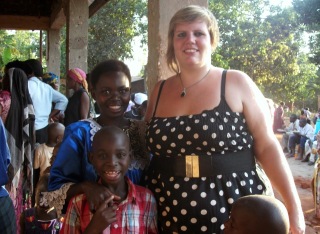 |
| Maama Derrick tailors the Glory Be school uniforms, using the money to contribure to Dericks’ SEN boarding school fees. |
 |
| Sadi lives with his grandparents and eighteen cousins. He co-sleeps with his grandma who run’s her busy household around Sadi’s additional needs. |
 |
| Sakira and her Grandmother adore each other. |
*One of these children does now live in a residential care home as her foster-grandmothers health deteriored with age and she was unable to physically care for her any longer. No family members could be traced. The home that was chosen for her follows a family style model of care.
How educating children with learning disability can contribute to sustainability….
I’ve been thinking a lot about sustainability lately. I’ve been involved in a few conversations about it. I would call them debates except, given that I *usually* surround myself with rational people, we usually agree: sustainable, good; non sustainable, try a bit harder.
It got me to thinking about the sustainability of our own project. Sustainability is a complex issues. It’s not as simple as making something financially sustainable; self-funding and therefore lasting. Of course, this is one of our aims. One that we are moving, slowly, towards. I’m currently working on funding proposals for grants which will provide Glory Be Nursery with income generating agricultural projects. This will have to be a on large scale otherwise we simple wont make enough funds to make it worth while.
 |
| This is our cow, Rachael. She provides milk for the kids in their porridge. |
At present the school fees are subsidised to make a quality education accessible to all the families in the village. The easiest way to make the school sustainable would be to raise the school fees. However, we would need to at least quadruple the school fees in order to cover all the cost associated with running the nursery. This would be impossible unless we worked with all of our 150 odd families to increase their own capacity (and consequently income) so that they be able to pay these new fees.This would be ideal, this would be wonderful.
 |
| Our uniforms are tailored by Maama Derick (not pictured) which provides employment for one of our parents of a child with learning difficulties. |
Capacity building through vocational training and micro-finance is one of the aims of Buwenda Women in Action, our community based partner organization. At present BWA have a goat rearing program whereby goats are bread and passed on to the next member with the aim that each member will soon have their own goat. It’s small but it’s a start. BWA have numerous income generation plans for individuals or collectives, the current issue being funding and start up capital. However, this aside, it would be simplistic to think that every family would be able or indeed willing to engage in these programs let alone that the kind of income generated would be enough to make it possible to pay four times the current nursery fees (plus uniform, plus porridge etc etc) as well as supporting their other children’s education.
 |
| Bernard chills out with one of BWA’s goats. |
Instead, we’re looking at the wider picture of sustainability. Education, in itself is sustainable. It’s goals are longer term, of course. It will take 20 years, but *hopefully* little Gift who enrolled in Baby Class this year will have been afforded a quality education, and more than that, a positive attitude toward education, that means she will be both financially stable enough and motivated to pay her for own children’s quality education…and health care….and all the other associated cost of bringing up a healthy, happy child. And perhaps she will be doctor, or an engineer, or a (honest!!) politician…
 |
| I just love this photo. |
This is why we concentrate on early years education. We feel strongly that by giving children a foundation of core skills and values they are far more likely to succeed in education. Of course, the very fact that children who have attended nursery will know their alphabet, numbers and have mastered basic pencil skills before they reach their Primary 1 class of 120 pupils is a huge advantage. But not only that, by learning from the youngest of age that education is fun and valuable they will go on to have a positive relationship with education in the future.
So, how do children with disability fit into this model? I often feel that this is our biggest obstacle; convincing the skeptical that educating children with learning difficulties is worthwhile and even sustainable. Here’s how it works:
1. By providing a safe, nurturing environment for children with learning disability, we are providing their carer respite. Many of our guardians would be unable to get on even the most simple of daily tasks whilst taking full time care of the child. Constant supervision to ward of dangers, additional toileting needs, feeding issues can get in the way of basic cooking, cleaning and washing, let alone digging or formal employment.
Where employment is an option, many of our guardians have been unable to take this on as they cannot find appropriate childcare.
Similarly, some of our children have been cared for by their older siblings or cousins to the extent that they are kept home from educational opportunities. This, obviously, is not sustainable.
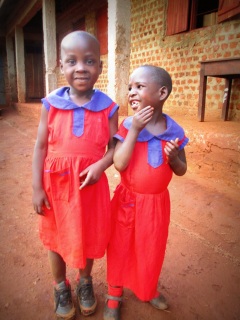 |
| Christine (left) helps to look after her auntie (!) Peace (right) when they’re not at nursery so that their grandparents can work. |
Even four hours a day (some of children with special needs stay for up to 8 hours daily), can give carers enough time to run the house hold, access work and/or education and even just to recoop. This is helping to support a family to be hold itself together and sustain itself.
 |
| All four of Maama Nam’s children have learning difficulties. We have supported three of her children over the past three years so that she can get some time to carry out day to day activities. |
2. We provide children with learning disability skills that can help them be more independent and even help out at home. Self-care skills (not least, independent toileting!), life skills (e.g. washing up, sweeping etc), a sense of personal identity, independence, personal safety and so on. By increasing a child’s skills base, we are freeing their carers up to participate in other meaningful activities.
3. We work with children with developmental delay (usually from infantile sickness but sometimes from neglect or malnourishment). These children are sometimes discounted educationally and left at home by parents, community or teachers. In fact, many children in this situation do not have a pervasive disability. With our support, these children can often catch up their milestones and move on to mainstream education and never look back.
4. Despite some people’s beliefs, people with learning difficulties can go on to have jobs, families and a wonderful existence. I have hopes and dreams for all of the kids we support. I can envisage Sakira working in a restaurant in town, and I can see Sadi as a sought after technician fixing every bust radio and mobile in Jinja District….These children may go on to be adults who can support and sustain themselves. (Okay this might not be realistic for all our kids, but we should be working towards it!)
If we give up on these kids before they are even primary age they will not have the support and education they need to enter employment and will continue to be added pressure on their families or, in the worst case scenario, they may be abandoned.
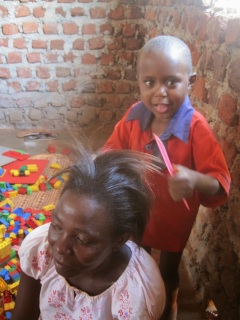 |
| Sadi is considering a career as a hair stylist |
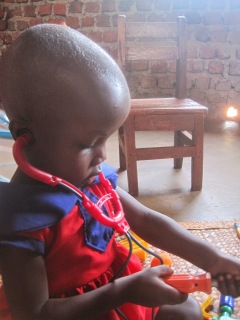 |
| Nam would like to be a nurse when she grows up. An operating theater nurse. Who assists with screwdrivers. |
5. By focusing on inclusion from an early age we are challenging society’s stigma relating to learning difficulties. Children are not born to marginalize and I am constantly delighted by how well the children with special needs are accepted at Glory Be Nursery. I am confident that these kids will grow up to be accepted within their community. They will not be refused jobs on the basis of their disability but given chances on the basis of what they have achieved. With a peer support network their additional needs will hopefully be catered for and their vulnerability reduced.
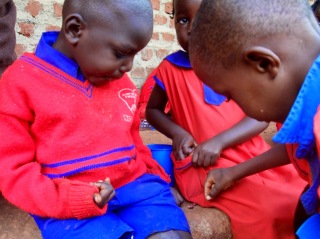 |
| Destiny sharing snack with friends at play time. |
 |
| Sakira is a lively and popular member of Top Class. |
So there you have it. My case for why educating children with learning disability is, in itself sustainable at least to some degree. Yes, we have some work to do to make our current projects self-sustaining, and we have a long road ahead to ensure each individual child we work with can participate in the sustainability of their own future but I like to think we’re on the right path.
Mary’s Determination
 |
| Mary with SEN Class pupil, Sakira |
However, days crept into weeks, and Mary’s daughter did not pass away. And though she remained weak and unresponsive hope returned. After sometime Mary was advised that she was out danger but that she would be left with permanent physical and learning disabilities.
 |
| Mary encourages Winnie to walk during an outreach session. |
One day, many months later, as Mary was administering some medicine to her child, she told her to open her mouth up wide. And for the first time since her sickness she followed an instruction. Bewildered and overjoyed Mary called to her other children to witness. They all laughed at their mother telling her she was imaging it until lo and behold she did it again for them. “Lift up your arms!” they told her and she did.
 |
| Immaculate playing party games with Baby Class |
 |
| Immaculate has no problems leading the whole school! |
 |
| Mary spent hours counselling Norman’s mother to cope with his special needs. |
When we first came to work with Mary, we did not know this story. But we were impressed from the first by her commitment, modern attitude and never-ending faith in the children and families we work with. Mary has come to be the cornerstone of our community work and is an example to mothers the world over who face the sometimes overwhelming weight of supporting a child with additional needs.
Dust
When I said I was going to write a blog about “dust” people laughed. But I’m doing it anyway!
 |
| Dust hangs off banana trees along the Budondo Road |
People underestimate the effect dust has on lives! They think of it as an inconvenience, which of course it is. During dry season you cannot go along for even 5 minutes along a dirt road without your entire body being covered in a thick film of orange. Boda drivers wear their jackets backwards and wrap scarves around their faces to protect their clothing and faces but you’ll usually find they still end up with bright orange eyelashes.
 |
| Boda driver, Sam, in his “dust proof” outfit! |
 |
| My foot, thoroughly dusted! |
But I have a more intense objection to dust. It’s dangerous!
Firstly, think about the consequences of a five year old walking 5 km to school everyday along this road breathing this in. Numerous kids in Buwenda have health complications due to dust, mainly respiratory: persistent coughs, chest and sinus infections and of course continually runny noses.
 |
| The roadside along which the children walk to nursery. Hundred’s more walk kilometres to school everyday! |
The dust blinds you when a truck or a car speeds past, temporarily of course. But actually, the bacteria contained within the dust can cause both simple and complicated eye infections as well as irritation. And not to mention the danger of a boda driver missing a potential hazard – perhaps a child – has he struggles to keep the dust out of his eyes!
One effect of dust that I had not ever considered before living in Uganda is this: during dry season water is scarce. Most people who live in Buwenda collect water from boreholes, the river and if they can scrape together enough pennies, they buy it from a local tap. To ease this burden collecting rainwater in tanks or even simply basins as it rolls of the corrugated iron roofs is commonplace. In dry season, when the rains come as infrequently as once every six weeks, one would wait with great anticipation to catch it! But alas, the roof is coated with dust! And the only water you can catch is thick and dirty and completely unusable.
Okay, so that is pretty much all I’ve got to say on the subject of dust. But I still think it’s worth thinking about!
Epilepsy
 |
| Home of Hope Ministries Director, Edith, gives a sensitisation speech during an outreach. |
 |
| The medical officer with Home of Hope Ministries distributes anticonvulsant medication free of charge in the community |
Communication in Small Steps
 |
| Sadi using resources as a means of communication |
 |
| Sadi tells us about his number work sheet |
 |
| Destiny “chats” to Teacher Christine |
Feeding Difficulties
 |
| Home of Hope OT, Eddie, kneels behind David while feeding him to help support the correct posture for swallowing. |
 |
| Luckily for Isaac, he lives close to a Soft Power Education SEN outreach clinic where he attends with his mum to improve his posture, muscle tone and his mum’s knowledge on feeding. |
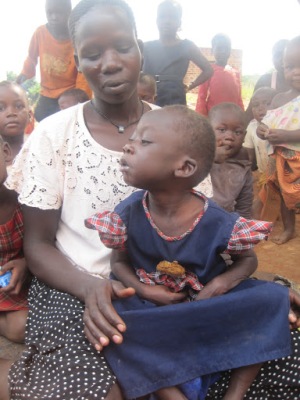 |
|
| Rachel, who has cerebral palsy and feeding problems, with her mum. Maama Rachel feeds her posho porridge and biscuits soaked in cows milk if she can get hold of it. |



